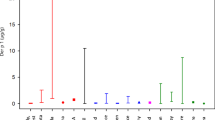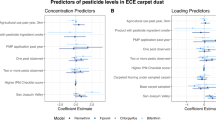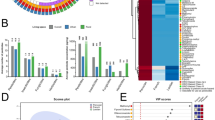Abstract
Fleas are a persistent problem for pets that require implementation of control measures. Consequently, pesticide use by homeowners for flea control is common and may increase pesticide exposure for adults and children. Fifty-five pet dogs (23 in study 1; 22 in study 2) of different breeds and weights were treated with over-the-counter flea collars containing tetrachlorvinphos (TCVP). During study 1, fur of treated dogs was monitored for transferable TCVP residues using cotton gloves to pet the dogs during 5-min rubbings post-collar application. Plasma cholinesterase (ChE) activity was also measured in treated dogs. Average amounts of TCVP transferred from the fur of the neck (rubbing over the collar) and from the back to gloves at 3 days post-collar application were 23,700±2100 and 260±50 μg/glove, respectively. No inhibition of plasma ChE was observed. During study 2, transferable TCVP residues to cotton gloves were monitored during 5-min rubbings post-collar application. Transferable residues were also monitored on cotton tee shirts worn by children and in the first morning urine samples obtained from adults and children. Average amounts of TCVP transferred to gloves at 5 days post-collar application from the neck (over the collar) and from the back were 22,400±2900 and 80±20 μg/glove, respectively. Tee shirts worn by children on days 7–11 contained 1.8±0.8 μg TCVP/g shirt. No significant differences were observed between adults and children in urinary 2,4,5-trichloromandelic acid (TCMA) levels; however, all TCMA residues (adults and children) were significantly greater than pretreatment concentrations (α=0.05). The lack of ChE inhibition in dogs and the low acute toxicity level of TCVP (rat oral LD50 of 4–5 g/kg) strongly suggest that TCVP is rapidly detoxified and excreted and therefore poses a very low toxicological risk, despite these high residues.
This is a preview of subscription content, access via your institution
Access options
Subscribe to this journal
Receive 6 print issues and online access
$259.00 per year
only $43.17 per issue
Buy this article
- Purchase on Springer Link
- Instant access to full article PDF
Prices may be subject to local taxes which are calculated during checkout



Similar content being viewed by others
References
American Veterinary Medical Association. US Pet Ownership and Demographics Sourcebook. Center for Information Management, American Veterinary Association, Schaumburg, IL, 1997.
Barr D.B., Wilder L.C., Caudill S.P., Gonzalez A.J., Needham L.L., and Pirkle J.L. Urinary creatinine concentrations in the US population: implications for urinary biologic monitoring measurements. Environ Health Perspect 2005: 113 (2): 192–200.
Barr D.B., and Angerer J. Potential uses of biomonitoring data: a case study using the organophosphorus pesticides chlorpyrifos and malathion. Environ Health Perspect 2006: 114: 1763–1769.
Berger J., Valdez S., Puschner B., Leutenegger C.M., Gardner I.A., and Madigan J.E. Effects of oral tetrachlorvinphos fly control (Equitrol®) administration in horses: physiological and behavioural findings. Vet Res Commun 2007, e-pub ahead of print, 24 May 2007.
Boone J.S., Tyler J.T., Davis M.K., and Chambers J.E. Effects of topical phosmet on fur residue and cholinesterase activity of dogs. Toxicol Mech Meth 2006: 16 (5): 275–280.
Boone J.S., Tyler J., and Chambers J.E. Transferable residues from dog fur and plasma cholinesterase inhibition in dogs treated with a flea control dip containing chlorpyrifos. Environ Health Perspect 2001: 109 (11): 1109–1114.
Castorina R., Bradman A., McKone T.E., Barr D.B., Harnly M.E., and Eskenazi B. Cumulative organophosphate pesticide exposure and risk assessment among pregnant women living in an agricultural community: a case study from the CHAMACOS cohort. Environ Health Perspect 2003: 111 (13): 1640–1648.
Chambers J.E., Boone J.S., Davis M.K., Moran J.E., and Tyler J.W. Assessing transferable residues from intermittent exposure to flea control collars containing the organophosphate insecticide chlorpyrifos. J Expo Sci Environ Epidemiol 2007: 17 (7): 656–666.
Colt J.S., Lubin J., Camann D., Davis S., Cerhan J., Severson R.K., Cozen W., and Hartge P. Comparison of pesticide levels in carpet dust and self-reported pest treatment practices in four US sites. J Expo Anal Environ Epidemiol 2003: 14: 74–83.
Ecobichon D.J. Toxic effects of pesticides. In: Klassen CD. (Ed.). Casarett and Doull's Toxicology. McGraw-Hill, New York, NY, 1996, 5th edn. pp. 643–698.
Fenske R.A., Black K.G., Elkner K.P., Lee C., Methner M.M., and Soto R. Potential exposure and health risks of infants following indoor residential pesticide applications. Am J Public Health 1990: 80 (6): 689–693.
Fenske R.A., and Day Jr E.W. Assessment of exposure for pesticide handlers in agricultural, residential and institutional environments. In: Franklin CA and Worgan JP. (Eds.). Occupational and Residential Exposure Assessment for Pesticides. John Wiley and Sons Ltd., Hoboken, NJ 2005, pp. 13–43.
Geer L.A., Cardello N., Dellarco M.J., Leighton T.J., Zendzian R.P., Roberts J.D., and Buckley T.J. Comparative analysis of passive dosimetry and biomonitoring for assessing chlorpyrifos exposure in pesticide workers. Ann Occup Hyg 2004: 48: 683–695.
Honeycutt R.C., Honeycutt M., DeGeare M., Day E.W., Houtman B., Chen G., Shurdut B.A., Nolan R.J., Vaccaro J.R., Murphy P., and Bartels M.J. Use of simultaneous biological monitoring and dermal dosimetry techniques to determine the exposure of chlorpyrifos to applicators and reentry workers. In: Honeycutt RC and Day EW. (Eds.) Worker Exposure to Agrochemicals, ACS Symposium Series CRC, Lewis Publishers, Baton Rouge, FL, USA, 2000, pp. 21–34.
Hore P., Robson M., Freeman N., Zhang J., Wartenberg D., Ozkaynak H., Tulve N., Sheldon L., Needham L., Barr D., and Lioy P.J. Chlorpyrifos accumulation patterns for child-accessible surfaces and objects and urinary metabolite excretion by children for 2 weeks after crack-and-crevice application. Environ Health Perspect 2005: 113 (2): 211–219.
Kissel J.C., Curl C.L., Kedan G., Lu C., Griffith W., Barr D.B., Needham L.L., and Fenske R.A. Comparison of organophosphorus pesticide metabolite levels in single and multiple daily urine samples collected from preschool children in Washington State. J Expo Anal Environ Epidemiol 2005: 15: 164–171.
Luke B.G., and Dahl C.J. Detection of O,O-diethyl-O-(2,5-dichlorophenyl) phosphorothioate and O,O-diethyl-O-(3,6-dichloro-2-pyridyl) phosphorothioate in meat fat. J Assoc Off Anal Chem 1976: 59: 1081–1087.
Morgan M.K., Stout II D.M., and Wilson N.K. Feasibility study of the potential for human exposure to pet-borne residues following lawn applications. Bull Environ Contam Toxicol 2001: 66: 295–300.
Rohrer C.A., Hieber T.E., Melnyk L.J., and Berry M.R. Transfer efficiencies of pesticides from household flooring surfaces to foods. J Expo Anal Environ Epidemiol 2003: 13: 454–464.
USEPA. Test Methods for Evaluating Solid Waste, Physical/Chemical Methods 1993. EPA 530/SW-846.
USEPA. TCVP Registration Eligibility Decision. United States Environmental Protection Agency, Washington, D.C., 1995.
Woody R.C. The clinical spectrum of pediatric organophosphate intoxications. Neurotoxicology 1984: 5: 75.
Zweig G., and Sherma J. Analytical methods for pesticides and plant growth regulators. In: Zweig G. (Ed.). Gas Chromatographic Analysis. Academic Press, New York, NY, 1977, Volume VI, pp 408–413.
Zwiener R.J., and Ginsburg C.M. Organophosphate and carbamate poisoning in infants and children. Pediatrics 1988: 81: 121–126.
Acknowledgements
This research was supported by grants from the US Environmental Protection Agency's Science to Achieve Results (STAR) grant program (Grant nos. R825170 and R828017). Although the research described herein has been funded wholly or in part by the US Environmental Protection Agency STAR program, it has not been subjected to any governmental review and therefore does not reflect the views of the agency. No official endorsements should be inferred. We thank Ms. Nicole Holifield, Ms. Susan Waldrop, and Mr. Collin Zumwalt for residue analyses, as well as creatinine and cholinesterase assays, Drs. Carolyn Boyle and Sumalee Givaruangwawat for statistical advice, and Dr. Louis Ruzo and Curtis Hatton (PTRL West Inc.) for the analysis of urine for TCMA. This research was also supported by the Mississippi Agriculture and Forestry Experiment Station (MAFES) and the College of Veterinary Medicine, Mississippi State University. This article is MAFES publication number J11104 and the Center of Environmental Health Sciences publication number 113.
Author information
Authors and Affiliations
Corresponding author
Rights and permissions
About this article
Cite this article
Davis, M., Boone, J., Moran, J. et al. Assessing intermittent pesticide exposure from flea control collars containing the organophosphorus insecticide tetrachlorvinphos. J Expo Sci Environ Epidemiol 18, 564–570 (2008). https://doi.org/10.1038/sj.jes.7500647
Received:
Revised:
Accepted:
Published:
Issue Date:
DOI: https://doi.org/10.1038/sj.jes.7500647



